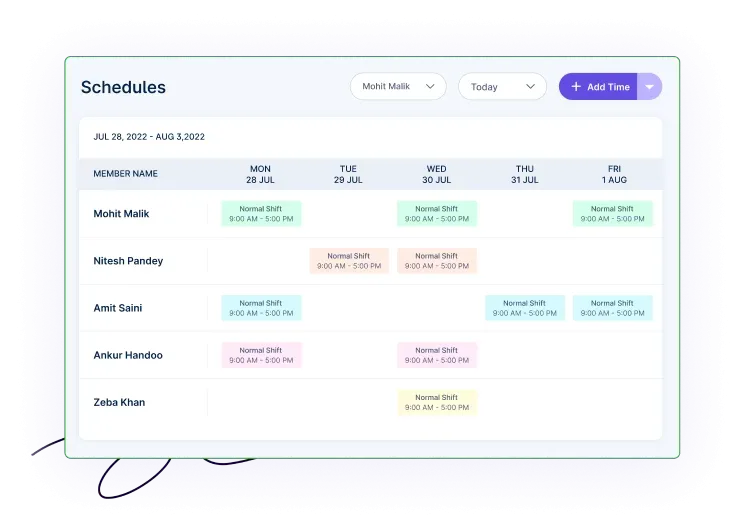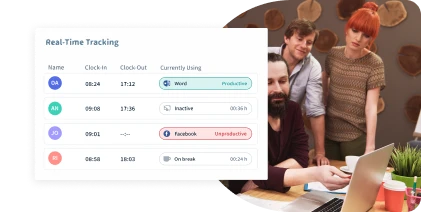Table of Contents
Are you tired of feeling overwhelmed with your work schedule?
Do you wish there was a way to better predict when and where you’ll be working in advance?
Well, predictive scheduling is the answer you are looking for!
This innovative concept is revolutionizing the world of employee scheduling by harnessing the power of data analysis with its ability to:
- Optimize workforce allocation
- Improve employee satisfaction
- Enhance operational efficiency
Predictive scheduling has become increasingly relevant across various industries. With the increasing need for:
- Flexibility
- Accuracy
- Predictability
- Cost Effectiveness
It’s no wonder that businesses and organizations are turning to predictive scheduling to manage their workforce.
In this blog, we’ll explore everything you need to know about what predictive scheduling is, from:
- Historical background and evolution of predictive scheduling
- Components of predictive scheduling
- Legal and regulatory landscape surrounding predictive scheduling
To the challenges and solutions that come with predictive scheduling, this blog will provide complete coverage, helping you understand the concept and its implications on your business.
So let’s get started by understanding.
What Is Predictive Scheduling?
Predictive scheduling is a proactive approach to employee scheduling that utilizes the following:
- Historical data
- Forecasting techniques
- Advanced algorithms
To predict and optimize work schedules in advance. It aims to anticipate the demand for labor based on the following:
- Historical patterns
- Market trends
- Other relevant factors
By leveraging data analysis and automation, predictive scheduling allows organizations to create more accurate, efficient, and flexible schedules.
Historical Background & Evolution of Predictive Scheduling
Predictive scheduling has evolved in response to changing labor practices and the need for greater efficiency in workforce management.
Let’s take a closer look at the historical background and key milestones in the evolution of predictive scheduling.
The Emergence Of Shift Work:
- In the early 20th century, manufacturing, healthcare, and transportation industries began adopting shift work schedules to meet round-the-clock operational demands.
- Fixed schedules with rigid shifts were common during this period, with little flexibility for employees.
Introduction Of Flexibility:
- As labor laws evolved and societal expectations shifted, there was a growing recognition of the importance of work-life balance and employee well-being.
- The introduction of flexible work arrangements, such as:
- Part-time work
- Variable scheduling
- Shift swapping
Aimed to accommodate employee preferences and improve job satisfaction.
Rise Of Technology:
- The widespread adoption of technology, particularly computers and software systems, revolutionized scheduling practices.
- Computerized scheduling systems allowed for more efficient and accurate scheduling, reducing manual errors and enabling better resource allocation.
Demand Forecasting & Optimization:
- With the availability of data analytics and forecasting techniques, organizations began to analyze historical data, market trends, and other variables to forecast labor needs accurately.
Legal & Regulatory Initiatives:
- Recognizing the importance of stable and predictable work schedules, some jurisdictions introduced predictive scheduling legislation.
- These laws protect employee rights, ensure fair scheduling practices, and provide advance notice of work schedules.
Workforce Management Software:
- The advent of sophisticated workforce management software solutions further enhanced the capabilities of predictive scheduling
- These software platforms integrate demand forecasting, employee availability tracking, shift optimization, and real-time adjustments to streamline scheduling processes.
Now that we have a basic understanding of what predictive scheduling is let’s take a closer look at:
Difference Between Traditional Scheduling/ Predictive Scheduling

Components Of Predictive Scheduling
Predictive scheduling relies on several key components to effectively optimize work schedules and accommodate the needs of both businesses and employees.
These components include:
Forecasting Demand And Workload:
By analyzing historical data, market trends, and other relevant factors, predictive scheduling aims to accurately anticipate the demand for labor.
This allows organizations to proactively align staffing levels with the anticipated workload, ensuring efficient resource allocation.
Employee Availability And Preferences:
Predictive scheduling considers individual employees’ availability and preferences.
Organizations can create schedules that accommodate employee needs while maintaining operational efficiency by considering factors such as:
- Preferred shifts
- Time-off requests
- Availability constraints
Scheduling Algorithms And Software Solutions:
Advanced algorithms and workforce management software are crucial in predictive scheduling. These tools:
- Automate the scheduling process
- Optimize shift assignments
- Streamline workflow
That allows businesses to generate schedules that are fair, compliant, and aligned with business objectives.
Real-Time Adjustments And Adaptability:
Predictive scheduling acknowledges that unforeseen changes may occur. To address this, it allows for real-time adjustments and adaptability.
Organizations can make schedule modifications based on the following:
- Unexpected events
- Employee requests
- Changes in demand
Ensuring that schedules remain optimized and responsive to evolving circumstances.
Now let’s look at the:
These were some benefits businesses and organizations attained by implementing predictive scheduling.
Now let’s move on to:
Enhancing Predictive Scheduling: Overcoming Predictive Scheduling Challenges With Innovative Solutions
Challenge 1-Complex Scheduling Requirements
Many organizations face the challenge of managing complex scheduling requirements, such as:
- Multiple shifts
- Different skill sets
- Varying employee availability
This makes it hard for employers to create accurate, efficient, and flexible schedules.
Solution 1- Advanced Scheduling Features And Customization Options

To address these challenges, organizations can turn to Workstatus, a comprehensive workforce management software that offers advanced scheduling features and customization options, including:
- Flexible shift scheduling
- Time off suggestions based on past participation and absences
- Customizable work schedules
- On-the-go shift changes
- Employee tracking and notification capabilities
This makes it easy for employers to create schedules that accommodate employee needs while meeting operational demands.
Challenge 2: Managing Remote And Distributed Teams
As remote work becomes more prevalent, managing remote and distributed teams poses unique challenges for employers. These challenges include:
- Tracking productivity and work hours
- Ensuring effective communication and collaboration
- Maintaining accountability and managing remote employee engagement
Without proper tools and solutions, these teams can experience productivity gaps, communication failures, and tension among team members.
Solution 2: Opting For Remote Workforce Management Tool:
Workstatus provides remote workforce management tools that empower employers to manage remote and distributed teams effectively.
Here are some features provided by Workstatus to help employers overcome some of the challenges associated with remote work:
1) Time Tracking –

This feature allows employers to track how long employees work, enhancing accountability and transparency in the time employees spend on different tasks and projects.
2) Employee Activity Tracking

This feature allows employers to monitor what URLs and apps employees use while working from home.

Moreover, it captures real-time screenshots of work done, providing complete visibility into employees’ operations.
3) Employee Productivity Monitoring

This feature provides detailed insights into the performance of employees, allowing employers to identify patterns and trends in employee productivity.
With such powerful tools at employers’ disposal, managing a remote team and achieving the desired outcomes becomes easier.
Challenge 3: Adapting To Last-Minute Changes And Unexpected Events
Last-minute changes and unexpected events are inevitable in the workplace and can disrupt scheduling plans. Some challenges include:
- Employee shift cancellations or substitutions
- Unplanned project delays or urgent tasks
- Equipment or resource failures impacting work schedules
Solution 3: Real-Time Notifications And Project Management

Workstatus offers real-time notifications and project management features that help employers address last-minute changes and unexpected events.
With instant notifications, employers can quickly update employees, ensuring everyone is informed about any changes or disruptions.
Additionally, robust project management tools enable organizations to:
- Allocate resources
- Reassign tasks
- Adjust schedules on the go
Ensuring minimal disruption to operations.
These are some of the challenges that employers face when it comes to predictive scheduling.

Using Workstatus, the one-stop solution for these challenges, makes it easy for employers to create accurate, efficient, and flexible schedules that help organizations to manage their workflow and workforce more effectively.
As we are now moving toward the final stage of the blog, let’s take a look at:
Future Trends In Predictive Scheduling
Advances In Technology And Automation In Predictive Scheduling
Advances in technology continue to shape the future of predictive scheduling. As businesses embrace digital transformation, there are emerging trends and challenges to consider
1) Automation:
Increasing automation in scheduling processes can streamline operations and improve efficiency. AI-powered algorithms can:
- Optimize schedules
- Deliver factor in multiple variables
- Generate intelligent recommendations
2) Integration With Other Systems:
Predictive scheduling software can integrate with other systems, such as:
- HR
- Payroll
- Customer relationship management (CRM) platforms
Allowing for seamless data exchange and holistic workforce management.
3) Mobile Accessibility:
With the proliferation of mobile devices, future trends include mobile applications that provide employees with access to their:
- Schedules
- Shift changes
- Communication tools on the go
Potential Ethical Considerations And Concerns
As predictive scheduling becomes more prevalent, ethical considerations arise that need careful attention:
1) Employee Privacy:
Monitoring tools and data collection for predictive scheduling raise privacy concerns.
It is essential to balance the need for data-driven decision-making with respecting employees’ privacy rights and maintaining transparent practices.
2) Worker Well-Being:
Predictive scheduling should not compromise the well-being of employees.
Striking a balance between optimizing schedules and ensuring:
- Adequate rest periods
- Breaks
- Reasonable work hours
Known to be highly crucial for employee health and satisfaction.
Next Step
In conclusion, predictive scheduling is a method used by businesses to forecast and plan employee work schedules based on historical data and predictive analytics. It aims to:
- Optimize workforce management
- Improve employee satisfaction
- Enhance operational efficiency
Integrating a reliable workforce management software like Workstatus should be your next step to ensure smooth predictive scheduling management.
Workstatus provides advanced features and tools for:
- Accurate forecasting
- Efficient scheduling
- Real-time monitoring
Empowering businesses to implement predictive scheduling effectively.
Implementing Workstatus as part of predictive scheduling can significantly enhance workflow and assist organizations in managing their workforce more effectively.
FAQ
Q1: How does predictive scheduling improve employee satisfaction?
A1: Predictive scheduling considers employee:
- Preferences
- Availability
- Constraints
By providing stability, predictability, and flexibility in work schedules, it can enhance employee satisfaction and improve work-life balance.
Q2: How can predictive scheduling overcome scheduling challenges?
A2: Predictive scheduling can overcome challenges through:
- Advanced scheduling features
- Customization options
- Workforce management software
That addresses complex scheduling requirements, manages remote and distributed teams, and adapts to last-minute changes and unexpected events.
Q3: Can Workstatus help with compliance with predictive scheduling regulations?
A3: Yes, Workstatus can help organizations comply with predictive scheduling laws and regulations by providing features and tools that ensure:
- Fair and transparent scheduling practices
- Provide advance notice of work schedules
- Avoid penalties associated with non-compliance









